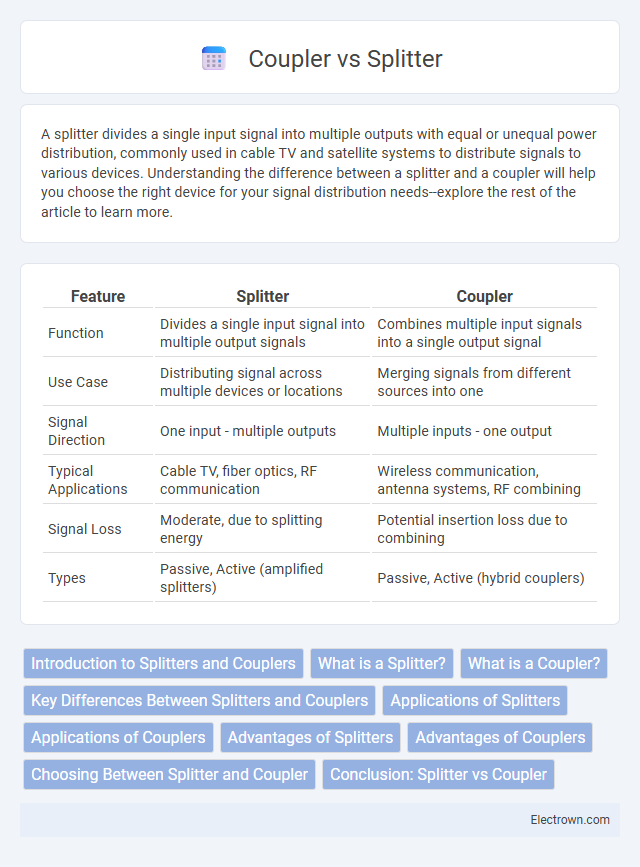A splitter divides a single input signal into multiple outputs with equal or unequal power distribution, commonly used in cable TV and satellite systems to distribute signals to various devices. Understanding the difference between a splitter and a coupler will help you choose the right device for your signal distribution needs--explore the rest of the article to learn more.
Table of Comparison
| Feature | Splitter | Coupler |
|---|---|---|
| Function | Divides a single input signal into multiple output signals | Combines multiple input signals into a single output signal |
| Use Case | Distributing signal across multiple devices or locations | Merging signals from different sources into one |
| Signal Direction | One input - multiple outputs | Multiple inputs - one output |
| Typical Applications | Cable TV, fiber optics, RF communication | Wireless communication, antenna systems, RF combining |
| Signal Loss | Moderate, due to splitting energy | Potential insertion loss due to combining |
| Types | Passive, Active (amplified splitters) | Passive, Active (hybrid couplers) |
Introduction to Splitters and Couplers
Splitters and couplers are essential components in optical and RF communication systems used to divide or combine signals efficiently. A splitter separates a single input signal into multiple outputs with minimal loss, ideal for distributing signals across various devices. Conversely, couplers merge multiple input signals into a single output, optimizing your network's signal management and connectivity.
What is a Splitter?
A splitter is an optical device that divides a single input signal into multiple output signals, commonly used in fiber optic networks to distribute data efficiently across various devices. It operates by splitting the optical power without converting signals from optical to electrical, ensuring minimal signal loss and high transmission quality. Splitters are essential in Passive Optical Networks (PON) for delivering broadband internet to multiple users from a single optical fiber.
What is a Coupler?
A coupler is an optical device that combines or splits light signals in fiber optic networks, enabling efficient signal distribution and management. Unlike a splitter, which divides one input signal into multiple outputs evenly, a coupler can merge signals from different fibers into one or evenly split signals with minimal loss. Understanding the function of a coupler helps optimize your fiber optic system's performance and connectivity.
Key Differences Between Splitters and Couplers
Splitters and couplers serve different purposes in optical and RF systems; splitters divide a single input signal into multiple output signals, typically with equal power distribution, while couplers combine or split signals with specific power ratios for signal routing or monitoring. Splitters generally have high insertion loss due to the division of power among outputs, whereas couplers are designed to maintain signal integrity with minimal loss and can provide directional coupling. The key differences lie in their functional design, signal handling capabilities, and typical use cases in network distribution versus signal management.
Applications of Splitters
Splitters are widely used in fiber optic networks to divide a single optical signal into multiple outputs, supporting applications such as passive optical networks (PONs) for internet, cable TV distribution, and telecommunication systems. They enable efficient bandwidth sharing by allowing one input fiber to connect with multiple endpoints, which is crucial in FTTH (Fiber to the Home) deployments and data center interconnects. Your network reliability and scalability can benefit from splitters by facilitating signal distribution without requiring additional power sources.
Applications of Couplers
Couplers are widely used in communication systems to combine or split signals, enabling efficient signal distribution in fiber optic networks and RF circuits. Your network infrastructure benefits from couplers by facilitating signal routing in antenna arrays, power monitoring, and signal injection for testing purposes. These devices ensure minimal signal loss and maintain integrity across applications like cable TV systems, satellite communications, and wireless networks.
Advantages of Splitters
Splitters enable efficient distribution of a single optical signal into multiple outputs without signal conversion, providing high reliability and minimal insertion loss. Their passive nature ensures low maintenance costs and stable performance in Fiber-to-the-Home (FTTH) and Passive Optical Network (PON) systems. Designed for scalability, splitters support easy network expansions while maintaining signal integrity across multiple endpoints.
Advantages of Couplers
Couplers offer distinct advantages by enabling efficient signal combining or distribution with minimal insertion loss, preserving signal integrity across multiple ports. Their ability to handle higher power levels and provide better isolation between channels makes them ideal for complex RF and optical systems. Couplers also support versatile network configurations, enhancing system flexibility and performance in telecommunications and broadcasting applications.
Choosing Between Splitter and Coupler
Choosing between a splitter and a coupler depends on your network's specific signal distribution needs and bandwidth requirements. Splitters divide a single input signal into multiple outputs, typically causing signal loss, whereas couplers combine or distribute signals with minimal loss, often used to merge or separate frequency bands. Understanding your system's tolerance for signal attenuation and the purpose of signal routing will help ensure optimal performance with the right device.
Conclusion: Splitter vs Coupler
Splitters and couplers serve distinct purposes in fiber optic networks, with splitters dividing a single signal into multiple outputs evenly, while couplers combine or distribute signals with varying ratios. Your choice depends on whether you need to distribute signals uniformly across multiple fibers or manage signal flow between different optical paths. Understanding their functional differences ensures optimal network performance and efficient signal management.
Splitter vs Coupler Infographic

 electrown.com
electrown.com